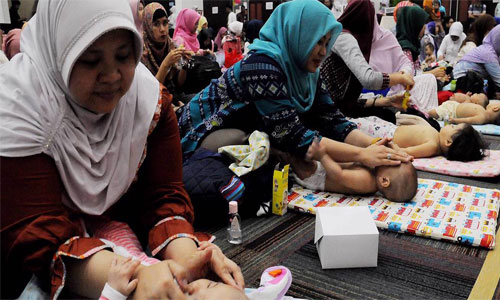Indonesia, home to 264 million people, is the world’s fourth-most populous country. Its capital, Jakarta, is the second-most populous urban area on Earth. For the sake of its long-term economic and social health, ending population growth should be a priority. As Indonesian President Joko Widodo (widely known as Jokowi) acknowledged in 2016, “Family planning is key for the success of future generations.”
And not just in Indonesia. Lower population growth translates into higher per capita GDP, leading to higher incomes, savings, and investment. By contrast, high population growth can reinforce an intergenerational cycle of poverty, with young people in large families often lacking access to the skills, tools, and opportunities they need to improve their future.
In 1970, Indonesia’s National Population and Family Planning Board (BKKBN) was launched to address the problem. It had two specific goals: to establish a “small, prosperous family” as the norm in Indonesia and to reduce fertility through the promotion of contraceptives.
At first, the BKKBN’s family-planning efforts achieved extraordinary results. By 2000, after 30 years of focused action, total fertility dropped by 54%, from 5.6 births per woman to 2.6, making Indonesia’s family-planning program one of the most effective in history.
But progress stalled before Indonesia achieved its objective of achieving replacement-level fertility (2.1) by 2010-2015. According to the United Nations, Indonesia’s total fertility rate in 2015 was 2.45.
[Chart]
The BKKBN is now targeting replacement-level fertility by 2025. This is feasible and could enable Indonesia to achieve its second key quantitative target – stabilizing population growth by 2050 – on schedule. But that means identifying the major barriers to success and designing a strategy to overcome them, using past successes as a guide.
One such barrier is erected by regional governments, most of which still do not regard family planning as a priority. The central government’s efforts to reduce fertility to replacement level will have little impact without the committed engagement of Indonesia’s 511 autonomous regions.
While efforts are already underway to increase awareness of family planning’s paramount importance and move it higher on subnational authorities’ agenda, that is just the first step. Governments at all levels must also collaborate more effectively with local communities. In fact, widespread outreach and community participation at the village level was a key reason for the success of past family-planning efforts in Indonesia.
At its peak, Indonesia’s rural family-planning program included nearly 40,000 field workers and more than 100,000 volunteers, serving even the most remote communities. These personnel conducted home visits to discuss family-planning methods, provided counseling, and made referrals to community health centers.
Widodo has attempted to revitalize this outreach effort by investing in Kampung KB, a program intended to improve village communities’ welfare and quality of life by expanding access to long-acting contraceptives, providing free services, and offering peer education programs. As part of this initiative, intra-uterine devices (IUDs), condoms, and implants are now offered free of charge to all couples that need them.
But such initiatives run up against another major barrier to progress: the stigma against women – particularly unmarried women – who seek family-planning services. Past family-planning programs partly overcame this obstacle by focusing on their efforts’ compatibility with cultural, religious, and social norms. Because of this sensitivity, religious leaders not only accepted the need for improved family planning; they actually preached about it, providing relevant information to their congregations. Moreover, schools included population-related issues in their curricula. The slogan “Dua Anak Cukup” (“Two Children are Enough”) became ubiquitous.
The same should happen today. Family-planning advocates should adopt a culturally and religiously sensitive approach that convinces community leaders to embrace the cause and, in particular, support birth control methods for unmarried individuals. Health-care services, as well as community- and school-based programs, should provide relevant information and sexuality education, in addition to counseling.
Designing such a comprehensive approach will require, among other things, a clear picture of public needs and perceptions. The BKKBN recently announced that it will be conducting studies on that and another key issue: teenagers’ reproductive health.
Progress on reducing the adolescent fertility rate, like progress on lowering overall fertility in Indonesia, has plateaued in recent decades. Changing this will require closer collaboration between youth programs and organizations that advocate for adolescent sexual and reproductive rights.
But no policy will work without greater engagement by men. According to Nofrijal, the BKKBN’s principal secretary, the organization wants to understand better “what types of contraceptives are needed and are favored by the public, both men and women.”
In the past, official policies reinforced the view that women are solely responsible for family planning. While there was once some interest in male contraceptive methods, a few conservative community leaders expressed alarm, disinformation proliferated, and these approaches were widely rejected. To reduce stigma and distribute responsibility fairly, however, men must participate more fully in family-planning processes.
Effective family planning is critical to a healthy, stable, and prosperous future. Indonesia has made remarkable progress toward replacement-level fertility. But to achieve that goal, everyone – married and unmarried men, women, and young people – must be included.
Home » Opinion » Going the Distance with Family Planning
Going the Distance with Family Planning
| Jenna Dodson

